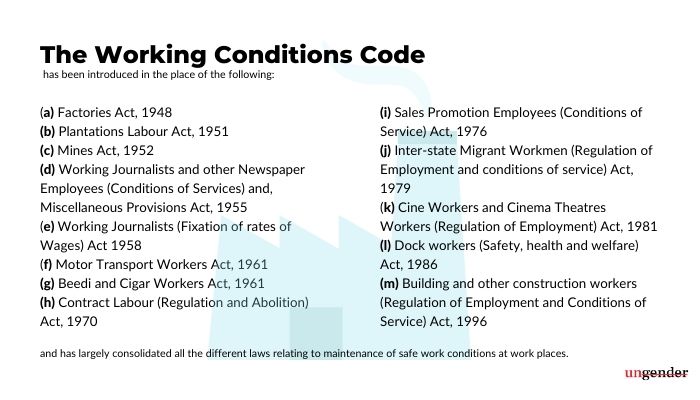Written by: Megha Chandra
On September 19, 2020, the new Labour Codes were passed which, are fated to be brought into force by the end of 2020. These Labour Codes seek to consolidate a myriad of labour laws enacted by the Central Government over the years (most of which are confusing, and have multiple overlapping provisions), and also, to introduce certain amendments.
Whilst the Labour Codes do consolidate various laws, this article is limited to explicating the impact of the provisions of these Labour Codes on (a) Women (cis; and transgender); and (b) disabled persons. For this purpose, the relevant codes and their provisions analyzed in this article are (1) Code on Social Security Act, 2020 ( “the Social Security Code”); (2) Occupational Health and Working Conditions code, 2020, (“the Working Conditions Code”); and (3) Code on Wages, 2019 (“Code on Wages”).
The remaining Codes, i.e. Industrial Relations Code, 2019 has made no change to the existing law qua the vulnerable sections of the society, and thus is not explained in detail.
Social Security Code
Under this Code, various forms of social security are provided for. This code subsumes, amongst others, the Maternity Benefit Act, 1961, the Employees State Insurance Act, 1948 , and the Employees Compensation Act, 1923 which were essentially the laws that provided a host of social security measures to women (in matters related to maternity) and to employees who suffered disablement or disease in course of their employment and also subsidized medical treatment and reimbursement under certain conditions to employees covered under this Code.
The provisions of social security, as they stand under the Social Security Code, are as follows:
Disablement Benefit
The disablement benefit is available to all employees of any establishment that employs 10 or more employees. Under this head, if an employee contracts an occupational disease or suffers an accident in course of employment ,then he/she is entitled to a sum of money from the government.
For availing this benefit, one will have to show that injury or the accident is directly attributable to the accident. For assessing the extent of disablement caused to an employee, and to what extent does such disablement causes a loss of earning is to be decided by a “Medical Board” set up under the Social Security Code.
There is also a provision that states that if an injured person’s injury or disablement gets aggravated over time, then the medical board can also enhance the compensation. Interestingly, a format of appeal is also available against the order of the Medical Board, and then ultimately before the Employees’ State Insurance Court. There is no real difference between the disablement benefit as it existed under the previous law in comparison to the law propounded in Social Security code.
Dependent’s Benefit
The dependent’s benefit is also available to the same class of employees to whom the Disablement Benefit is available.
It is essentially a sum of money that is paid to the surviving family members of an employee who has died due to an injury sustained in course of employment.
This benefit, once granted, can be recalled if the authorities find that persons posing as dependents have misrepresented facts to obtain this sum, or if the dependents no longer fall within the definition of a ‘dependent’ owing to death, re-marriage or ceasing of infirmity or attainment of 25 years of age.
Medical Benefit
The third benefit available to employees of factories, mines, plantations and to other establishments employing more than 10 employees, the government provides reasonable medical, surgical and obstetric treatments through its system of medical treatment clinics and hospitals set up for this purpose, or through collaboration with other medical practitioners at a subsidized rates to the relevant employees and in certain cases, their families.
Maternity Benefit For Biological Mothers
Maternity benefit was available under the Employees State Insurance Act, 1948 and also under the Maternity Benefit Act, 1961, but has now been combined substantially under the Social Security Code, as employees are now required to choose whether they would choose the benefit available under the chapter relating to Employees State Insurance, or under the chapter that embodies the Maternity Benefit Act, 1961.
Maternity benefit now, is available to all women employed in factories, mines, plantations and in other establishments that employ more than 10 employees and is largely the same law as prevailing earlier, with some minor additions. The benefits of note, under the new Code are as follows:
a. It is illegal for an employer to knowingly employ a woman within six weeks from her delivery of child; miscarriage or medical termination of pregnancy;
b. Even if a woman chooses to work through a period, in which she would otherwise be entitled to maternity leave, she cannot be forced to do any work that is difficult, or tiring, or involves long hours of standing;
c. The maximum period of maternity benefit available to woman employee is 26 weeks, if she has no surviving children. If a woman does have two or more surviving children, then she is entitled to 12 weeks of leave with pay instead of 26 weeks.
d. If a woman dies during the period of maternity benefit availed by her, then such benefit is payable up-to the day of her death. However, if she dies and leaves a child behind, then maternity benefit for the full period is payable.
e. If the work done by a woman is such that can be done on a ‘work from home’ basis, then even after the expiration of her maternity leave, she can ask her employer for a ‘work from home’ model.
f. Along with maternity leave with pay, a woman is also entitled to a bonus of INR 3500/- in case no pre-natal confinement or post-natal care is being provided by the employer free of charge.
g. Once a woman employee joins back services after delivery, she is entitled to two breaks for nursing the child, until the child is one and a half years old.
Medical Reasons
h. In case a woman goes through a miscarriage, or has a medical termination of pregnancy, she will be entitled to leave with wages at the rate of maternity benefit for a period of 6 weeks immediately following the date of miscarriage or termination as the case may be.
i. In cases, where a woman undergoes a tubectomy operation, she is entitled to leave for two weeks with pay, after such operation.
j. Any illness arising out of pregnancy, delivery, premature birth of child, miscarriage, or medical termination of pregnancy entitles the woman to an additional month of leave with wages.
On Termination/Dismissal From Work
k. According to the maternity benefit law, as it stands now, a woman cannot be dismissed from work, or be given a notice for dismissal during the time when she is on maternity leave. Even if she is dismissed thereafter, she will still be entitled to maternity benefit, which can be scrapped only in cases where the woman employee is accused and punished for gross misconduct.
l. The maternity benefit is mandated to be paid in advance (for the period preceding the date of delivery) and within 48 hours after production of proof of delivery. In certain cases, an Inspector-cum-Facilitator can also be appointed for making payments due under maternity benefit. All complaints of non-payment of maternity benefit are to be made before such Inspector cum Facilitator and there is a provision for appeal as well. Such appeal will be made to a person designated by the appropriate government for this purpose.
Maternity Benefit For Adopting/Commissioning Mothers
To the same class of employees as above, if a woman legally adopts a child below the age of three years, or is a commissioning mother then she is entitled to a maternity benefit for a period of 12 weeks from the date when the child is handed over to the adopting mother.
Creche Facilities
Factories, mines, plantations and other establishments that have 50 or more employees, then it ought to have a creche facility within a prescribed distance or within the premises. Women employees will be allowed four visits in a day to visit the child. There is also an option for government organizations to pool in to make common creche facilities.
Equal Work, Equal Wages
The Code on Wages, which subsumes all previous statues relating to fixation of wages declares that there can be no discrimination in any establishment covered therein on the grounds of gender in matters relating to wages by the same employer, in respect of the same work or work of a similar nature done by any employee.
There ought to be no discrimination in wages, no discrimination on the ground of sex whilst recruiting except where the employment of women is prohibited by law.
The Working Conditions Code

The Working Conditions code is applicable to all industries where 10 or more workers are employed. Additionally, in establishments of any kind where hazardous or life-threatening work is carried out, regardless of the number of workers, this Code is applicable.
Under this code, all covered establishments have to provide adequate and suitable washing facilities for male and female employees separately. Further, separate bathing places, locker facilities for male, female and transgender employees have to be provided.
Under a welcome new provision in this Code, women are now entitled to be employed for all types of work, which earlier was not the case. Women, now, with their consent can even be employed before 6:00 am and after 7:00 pm.
In cases, where the Government is of the opinion that the employment of women (for their health and safety), then the government may require the employer to provide adequate safeguards prior to employment of women at such establishments.
Conclusion
All in all, there are miniscule additions made to the Labour codes as far as the vulnerable sections of the society are concerned, however, these changes, however minute they may be, are welcome, and have at least commenced the task of pulling our archaic laws into the 21st century that we live in.
Whilst the Labour Codes are facing criticism from the intelligentsia of our country on other aspects, as far as welfare provisions for women and trans persons are concerned, the Labour codes have made a promising start towards modernizing the laws to suit the ever-progressing work space that our country has.
About The Author: Megha studied law at the Gujarat National Law University (GNLU) and graduated in 2011. Since then, she has always been a litigating lawyer, first in Delhi and now in Mumbai. Apart from a commercial litigation practice, she also takes a keen interest in human rights in India and their enforcement at the grassroots level.
Ungender Insights is the product of our learning from advisory work at Ungender. Our team specializes in advising workplaces on workplace diversity and inclusion. Write to us at contact@ungender.in to understand how we can partner with your organization to build a more inclusive workplace.










